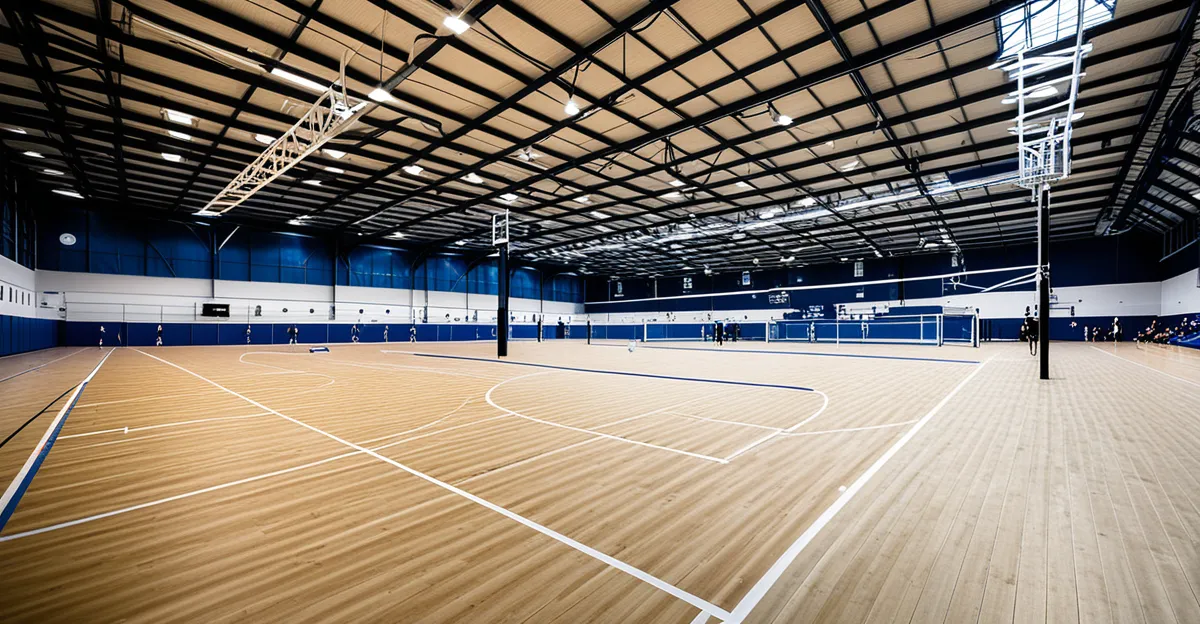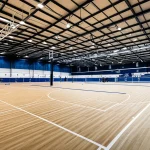The Changing Landscape of Indoor Sports Venues in the UK
Indoor sports venues have transformed the UK sports infrastructure significantly over recent years. These modern sports facilities reflect a shift from traditional outdoor fields to versatile, climate-controlled environments, enabling year-round participation regardless of weather. This transition supports growing demand for consistent training spaces and facilitates diverse sports activities within urban settings.
Innovations in facility design now emphasize flexibility and technology integration. Advanced flooring materials, improved lighting systems, and digital scoreboards enhance both athlete performance and spectator experience. Additionally, many venues incorporate sustainable technologies, aligning with broader environmental goals.
Also to read : How Can Participation in UK Sports Lead to Personal Growth?
Comparing indoor versus traditional outdoor venues reveals notable differences. Indoor sites offer controlled conditions, reducing cancellations and allowing for precise scheduling. While outdoor venues are subject to seasonal limitations, indoor facilities maximize usability and promote heavier programming. This evolution of indoor sports venues in the UK marks a critical step toward modernizing sports infrastructure to meet contemporary community and athletic needs.
Boosting Participation and Accessibility
Indoor sports venues play a crucial role in increasing sports participation rates across the UK. By providing accessible sports facilities that function year-round, these venues remove common barriers such as weather and seasonal limitations. This accessibility leads to consistent opportunities for individuals to engage in physical activities, directly contributing to healthier communities.
Also to read : What Are the Long-Term Benefits of Participating in UK Sports?
Inclusivity is another vital impact of modern indoor sports facilities. Many are designed to accommodate people with disabilities, incorporating features like level flooring, sensory-friendly environments, and adaptive equipment. These thoughtful designs foster inclusive sports environments, ensuring that diverse groups can participate fully and comfortably.
Data shows a clear rise in participation linked to indoor venues. For example, sports like badminton and futsal, popular in indoor settings, have seen increased community engagement. This trend underscores how improved access to quality facilities encourages more frequent involvement in sports, benefiting both grassroots athletes and casual participants.
Overall, indoor venues support broader community health goals by making sports more reachable and enjoyable for all, reinforcing their importance within the UK’s commitment to active lifestyles.
Transformation of Popular Sports Through Indoor Venues
The rise of indoor sports venues has profoundly influenced the popularity of several sports in the UK. Sports such as futsal, badminton, basketball, and climbing have seen substantial growth, largely due to the availability of climate-controlled, adaptable spaces. This evolution supports shifting preferences towards fast-paced, skill-focused sports suitable for indoor settings.
Innovations in sports facility design have introduced versatile courts and climbing walls, enabling multiple sports to coexist within a single venue. This adaptability encourages new forms of participation. For example, futsal’s fast gameplay benefits from the consistent surface and lighting of indoor courts, enhancing player performance and spectator appeal.
Moreover, the development of modern sports facilities has fostered the emergence of hybrid or newly adapted sports that suit indoor environments better than outdoor alternatives. These changes reflect an evolving sports culture that embraces innovation and diversity in athletic activities.
Overall, the transformation led by indoor venues reshapes how sports are played and experienced in the UK. It creates dynamic environments where both traditional and emerging sports thrive, contributing to a lively and expanding sporting community within indoor facilities.
Community Engagement and Social Integration
Indoor sports venues serve as vital hubs for community sports, fostering stronger social bonds in local neighborhoods. By offering year-round access, these facilities create safe, welcoming spaces where people of all ages can connect through shared physical activity. This accessibility helps reduce social isolation and encourages ongoing participation.
One of the key social benefits of sports within indoor venues is their ability to support after-school and youth development programs. These structured activities provide young people with positive outlets, promoting teamwork, discipline, and confidence in a controlled environment. Importantly, indoor venues often operate in urban areas where outdoor spaces might be limited, filling a crucial gap for community involvement.
Furthermore, indoor sports venues excel at promoting sports for all ages by hosting activities and leagues that encourage intergenerational participation. This inclusivity strengthens community cohesion and supports cultural diversity by welcoming people from different backgrounds and age groups into shared experiences. Consequently, indoor venues not only advance physical health but also enrich social integration and community spirit across the UK.
Youth Development and Grassroots Opportunities
Indoor sports venues play a pivotal role in youth sports UK by providing accessible, year-round facilities that nurture emerging talent. These modern venues host numerous grassroots sports development programs, offering structured coaching and competitive opportunities essential for early athletic growth. Their controlled environments ensure consistent training conditions, which are critical for skill progression and confidence building among young athletes.
Additionally, indoor sports venues facilitate effective talent identification through partnerships with schools and local clubs. Coaches and scouts rely on these spaces to observe youths in a variety of sports, from basketball to badminton, promoting comprehensive development pathways. The availability of adaptive and multi-sport setups allows youngsters to explore diverse disciplines, enhancing overall athleticism and interest.
By fostering collaboration between educational institutions, sports clubs, and community organizations, indoor venues strengthen the grassroots ecosystem. This integration supports not just elite talent but encourages broad participation, ensuring inclusive access to sport’s physical and developmental benefits. Ultimately, indoor sports venues are indispensable in cultivating the next generation of UK athletes while enriching community sport culture.



